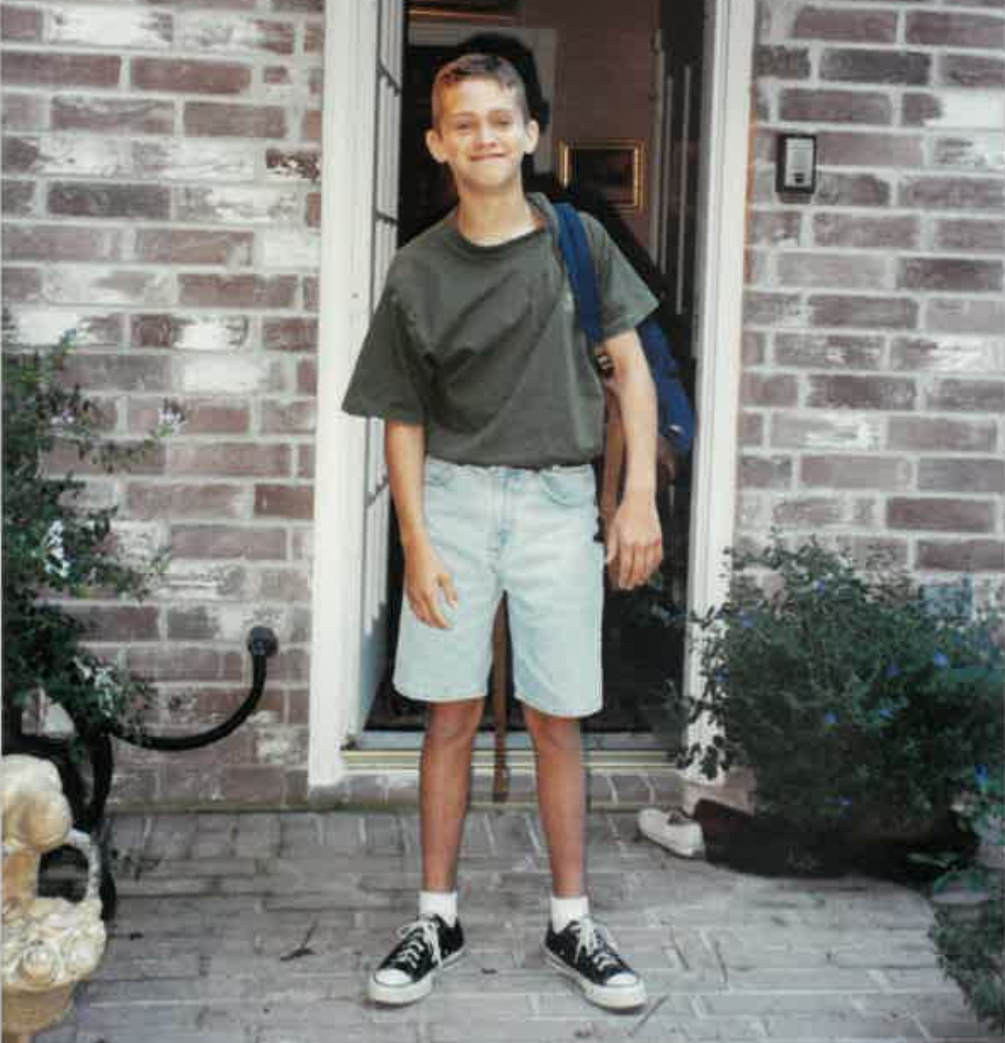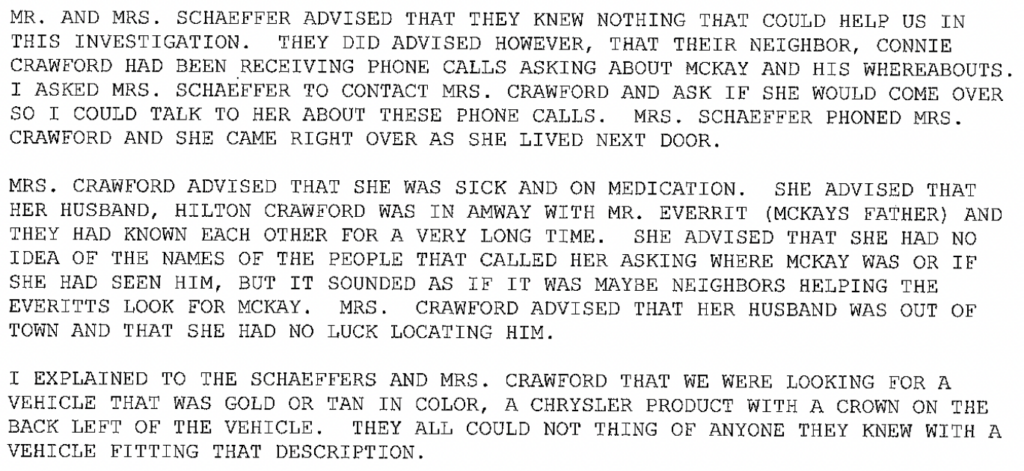
Episode one of the true-crime podcast Ransom: Position of Trust explores the day McKay disappeared and the beginnings of the investigation.
On September 12th, 1995 Carl Everett returned to his home in Conroe, Texas from an Amway meeting to find his back door propped open and his son McKay missing. Then the phone started to ring. On the line, a raspy-voiced woman demanded $500,000 if he ever wanted to see his son again. She said she’d call back at 8 am the next day, with details about how to make the payment.
Despite her warnings not to involve the police, Carl Everett called 911.
When McKay’s mother, Paulette, returned home from the Amway meeting and discovered McKay was missing, all she could do was scream. Already, a couple of Montgomery County sheriff’s deputies had arrived and were investigating the scene. But it was odd — there was no sign of a break-in or a struggle, and the house’s alarm system had been disabled.
“It was just as if McKay had walked out of his own free will,” said former deputy Sam Lynch, the first supervisor on the scene.
Investigators began to think McKay might’ve been abducted by someone who knew him well and could convince him to open the door.

Everyone Was a Suspect
The Everett’s home was soon filled with concerned friends and neighbors.
“Everyone there is a suspect, but not treated as such,” said Deputy Lynch. “Because everyone while they may be a suspect, they’re also a witness.”
And one of Carl’s neighbors, Bill Kahn, had seen something strange that night. When he took out the trash out around 8:45 pm, he’d seen a car speed down the Everetts’ driveway and away from the home. He took note of it, because it was driving unusually fast and almost crashed into his trash cans.
The car was dark brown or gold Chrysler — it was dark so he was unsure about the color — but he was sure that he’d seen a Crown Motors dealership sticker on the back of the car. The Crown sticker stuck out to him in particular because he was friends with the dealership’s owner.

The FBI Arrives
That night the FBI set up a mobile command point at the Everett’s home. Normally the FBI only gets involved in interstate crimes, but following the kidnapping of aviator Charles Lindbergh’s son, Congress passed the Federal Kidnapping Act of 1932, allowing the FBI to investigate kidnappings of children of a “tender age.”
The FBI kept a close eye on who was coming and going from the Everett home. They also asked the Everetts extensive questions about their acquaintances, which for the most part Carl answered because Paulette was still so rattled by the kidnapping that she could barely talk.
“When the FBI showed up, their questioning was very systematic,” says Paulette. “They immediately had us making lists.”
These lists included: people to whom McKay was close, people who drove a car resembling the gold or brown Chrysler with a crown dealership sticker that Bill Kahn had seen, and people who knew about the Amway meeting.
The Amway Connection
McKay had disappeared while Paulette and Carl were at an Amway meeting. Amway was a program, where you bought items wholesale from a mail-order catalog and resold them. But it was a multi-level marketing program, meaning you made money not just by selling products, but by recruiting more people into the Amway organization. The night of the kidnapping Carl Everett hosted a meeting in downtown Conroe to try to recruit new members.
The Everetts shared with the FBI a list of people who had attended the meeting as well as people they’d invited but who hadn’t shown up.
A New Lead Emerges
During the night, investigators learned of another lead. One of McKay’s friends, Elizabeth Schaeffer, had been on the phone with him around the time McKay had disappeared, and Investigators drove out to interview her in the middle of the night.
According to Elizabeth, McKay had called her at around 8:30, but then a few minutes later — in the middle of their conversation — McKay had told her to hold on for a second. She waited on the line for a while, but then never returned to the phone.

This pushed back the last time anyone had seen or spoken to McKay to 8:30, shortly before Bill Kahn had reported seeing the Chrysler with the Crown dealership sticker leaving the Everetts home.
While they were there, investigators also spoke with Elizabeth’s parents. They mentioned their neighbor, Connie Crawford, who was also a friend of the Everetts, might have some useful information.

The Crawfords were some of the first people Carl had contacted after receiving the ransom call. Connie’s husband Hilton Crawford was ex-law enforcement, so Carl thought he’d have good advice about what to do in this situation. But when Carl Everett called the Crawfords, Connie Crawford told him that Hilton was gone on an overnight business trip and she didn’t know how to reach him.
Waiting for the Ransom Call
Throughout the night, while some investigators followed up on leads, others set up equipment to record and trace all incoming calls to the Everett home. The ransom callers were supposed to call back at 8 am with details about how to pay the ransom. They’d known Carl had a cellphone and had asked him for its number. But in 1995, cell phones didn’t have caller ID, and calls were much harder to trace, so the FBI advised Carl to turn off his cell phone. Agents hoped that if the ransomers couldn’t get through to his cell, they’d call him back on the home line, and then they could trace the call.
The next morning, all eyes were on Carl, as he waited by the phone for the ransomer’s call.
But despite dozens of calls from friends and family, the ransom call never came.
The First Suspect
The FBI was still convinced that McKay had been abducted by someone who knew him well, so they started going down the list the Everetts had made of people McKay trusted enough to open the door for.
But the first person the FBI wanted to polygraph wasn’t on that list — or any of the lists the Everetts had made.
The first person the FBI wanted to polygraph was Carl Everett, McKay’s father.

Ransom: Position of Trust is a 9-part True Crime Podcast from KSL Podcasts. New episodes are released every Wednesday, with bonus episodes available on Fridays. Follow the Ransom Podcast for free on your favorite podcast app:



